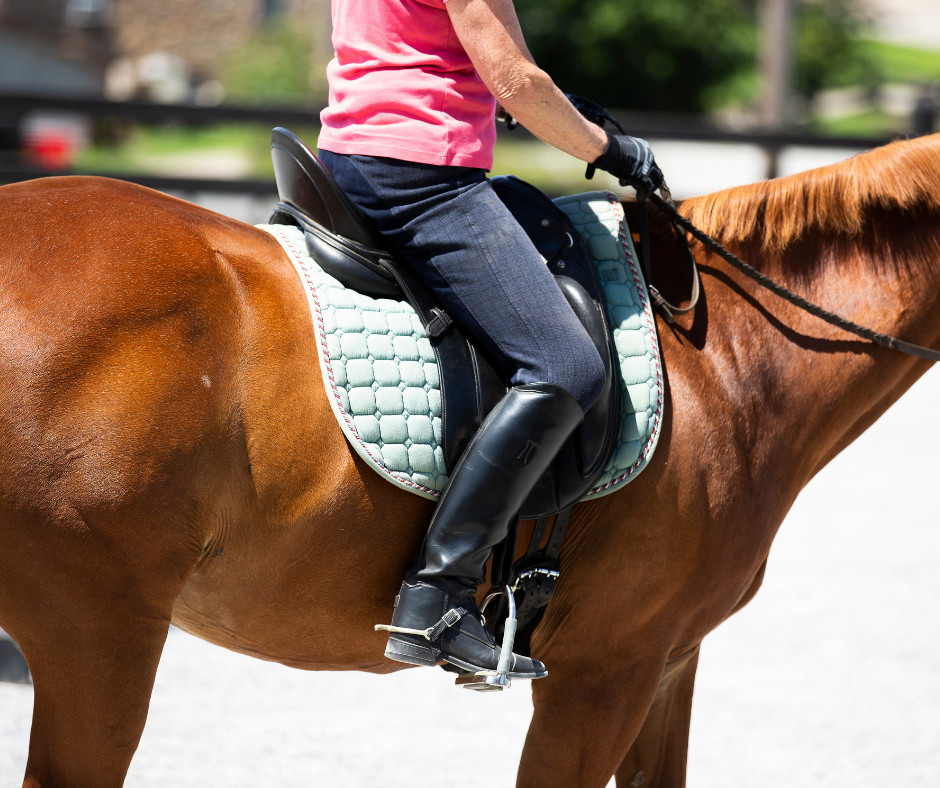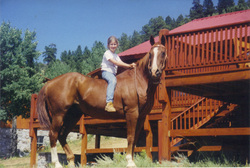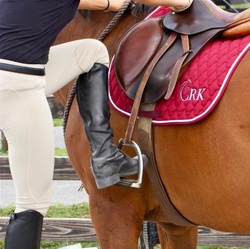Outside leg, inside rein, less hand, lift the rein… How do you know which cue to use when to communicate with your horse from the saddle? How do the great riders seem to do so little, and get such clear responses from their horse?
In today’s video, I describe the concept of becoming “fluent” in your riding aids.
Think of your riding as learning a new language. You begin with a limited vocabulary, only a few words. As you progress, you can start to create sentences, then paragraphs and your use of the language gradually becomes more descriptive, nuanced, and fluent.
The same process happens with our riding. Watch the video below to learn more!














6 Responses
i have a Tennessee Walker and would like help getting him into that rocking chair gait
Hi Nola, have you watched our video with Larry Whitesell on gaited horses? You should check it out here!
-Julia, CRK Training Community Manager
Thanks, Callie. Can you take this subject to the next step and talk more about balancing your horse, the importance of it and particularly how the inside leg to outside rein is so magical! I get the concept but when I’m on the (school) horse I forget how to apply the leg/rein so that he doesn’t fall into his inside shoulder.
Hi Victoria, we do go way deeper into certain subjects like the concept of inside leg to outside rein in our full online program, the Balanced Riding Course. We are running a workshop now that is the introduction to the course, you can sign up for the Free Online Riding Workshop by clicking here.
-Julia, CRK Training Community Manager
The comparison with learning to be fluent in a foreign language was very interesting. It takes a lot of repetitions and hard work – but so rewarding when someone actually understands you. I’m sure the horse and rider feels the same.
You can relax – the light has been turned on – from now on it is smooth sailing.
Exactly! It is just a way of communicating
-Julia, CRK Training Community Manager
I enjoyed this video! I never thought of using riding cues at the right time to parallel the idea of learning a new language! That is so clever! Another analogy is learning how to read….I used to be in the Volunteer Literacy Program and I taught illiterate adults to read. First we learned the sound of the letters, then put the letters together to make words, then words to make phrases, then sentences, etc. It was so exciting to see them learn to read! Another thought that came to mind was when I was visiting family in Houston earlier this year and we rented some horses. The guide told everyone that they needed to know three cues: go, stop, and turn. She made it sound like that’s all the people ever needed to know. I was thinking to myself that riding is more than that!
Combining many little cues to make riding more fluent certainly makes for better horsemanship.
Teri, that is also the same idea as what Callie was talking about in this video! Thanks for your comment
-Julia, CRK Training Community Manager
Speaking as someone who went to classes to learn a foreign language (Turkish!) I can relate to this! Nothing more rewarding than being understood even in the most basic attempts! Same on the horse, as a novice it’s good to be able to give a cue and have the horse respond even just to get a more forward walk! Although have got a bit further than that on the horse! Can’t say the same for the Turkish though! However the horseriding is priority now! Love your videos Callie, so informative and helpful.
Thank you Andrea, glad you enjoyed this video!
-Julia, CRK Training Community Manager
I’m finding it difficult to get the horse to respond to a cue to be more forward at the trot. No matter how much squeezing and the occasional kick, he maintains his slow trot. I don’t carry a whip, as he has never been ridden with one and is very averse to it–over-reacting. When I asked my instructor what else I can do to get a response, her answer was “He’s just got your number.” I feel stymied.
Hi Ruth, I don’t normally recommend this but if you have good control of your leg would spurs be an option to discuss with your instructor?
-Julia, CRK Training Community Manager
That was a really good analogy – learning a new language. I’ve started being able to use some of these cues and it’s such a great feeling when the horse stretches through its topline, Lowers his head, and lets out a long snort! So looking forward to getting back in the saddle after this long lockdown here in Melbourne.
Hope you are able to get back in the saddle soon Kerry!
-Julia, CRK Training Community Manager
Very enjoyable to listen to you and to watch the horse. As for me? Lately, although I am trail riding rather than working in the ring, there are things we can do. For example, I try to moderate the speed of the trot from a very slow smooth jog to a little faster, to a faster trot, and eventually to one fast enough to post rather than sit. So, the transitions to different speeds of trot is interesting and fun for both of us. I try to do this with as light a touch as I can.
Another exercise that is handy is to use inside leg to push the horse sideways away from an obstacle such as a bent tree even while using reins and outside leg to turn around the tree on a relatively steep uphill passage. This takes a little coordination because you are ducking under low branches while turning and moving laterally.
I find our horses are very sensitive, more sensitive than I am, as I try to refine my touch and feel.
Jon, those are both great exercises! More sensitive horses make us more sensitive riders
-Julia, CRK Training Community Manager
I used to cue the canter by a sequence: lift the inside rein, apply outside leg and kiss. Now my trainer is teaching me to apply my weight to the outside and simply look to the inside to cue the lead I want. It’s completely new to me but my horse is very responsive to weight shifts. I’m hoping this solves our wrong lead problems.
Hi Lynn, I would only caution you about the weight changes that we don’t want to weight one seatbone heavier than the other. Even the slightest imbalance is felt by the horse! I hope that you are able to solve your lead problems soon.
-Julia, CRK Training Community Manager
At the end of the video , the way you combed through the horses mane …..beautiful ….
The language analogy finds the same truth when we dive within ourselves ….making us to realise that to really dive deep , we have to make adjustments within ourselves , rather than making adjustment of any cushions or piling up more cushions!
Callie – Thanks for this – as a new rider, some days it feels like there is “so much” to remember / to learn – don’t get me wrong, I love it. This idea of it being like learning a new language really helps – patience with myself and a way to see how I am progressing. Always thought it would be French but this is way more fun. Have a great day!! Adelle
Always thought it would be French but this is way more fun. Have a great day!! Adelle
At this point my coach and I are still working on the posting trot, my balance, and getting my horse (Jake) to respond to basic cues with patterns and bending. Each time, I learn something new / improve something I have been working on.
I always wanted to learn a second language.
Hi Adelle, thanks for your comment! It can be so much to remember, there is always more to learn around horses
-Julia, CRK Training Community Manager
I love all your short shots on riding. I really do think as an instructor you should have your strap tight on your helmet. You are showing your audience how it should be worn every time you ride. If you can do it so can they. Just a thought, to promote safety.
Thank you for your kind approach in all of your teaching.
Thanks for being part of our community Carolyn!
-Julia, CRK Training Community Manager
Thank you so much, Callie! After, watching años some of your videos about the fear we have sometimes as riders, I realize now how important is to think more about being clear on communicating with my horse than being afraid . I have serious problems when cantering on the right side, because my horse has issues starting on the right side and, always my trainer tells me ”balance, balance” .. thanks to this video now I understand the balance importance and I will be taking care of such balance with all the cues! Thanks a lot and regards from Mexico.
Glad this video was helpful Karina, thanks for tuning in from Mexico!
-Julia, CRK Training Community Manager
Evening,
I have just headed back into riding after 20 years and it is the hand position that has me stuck as I keep getting reminded to hold the reins with thumbs up. It feels uncomfortable at the moment.
Congratulations on getting back into riding Sharon! This could be something you practice even while you aren’t riding, perhaps while driving or any other tasks you do often
-Julia, CRK Training Community Manager
Hi Callie, I love your videos I’m having a really hard time with all the cues. The hard I try the more confused my horse gets. I love how you slow it all down. Can’t wait to try them. I’m just getting back into riding again and going from saddleseat and Saddlebreds to dressage and quarter horse. It’s a lot hard then I thought..